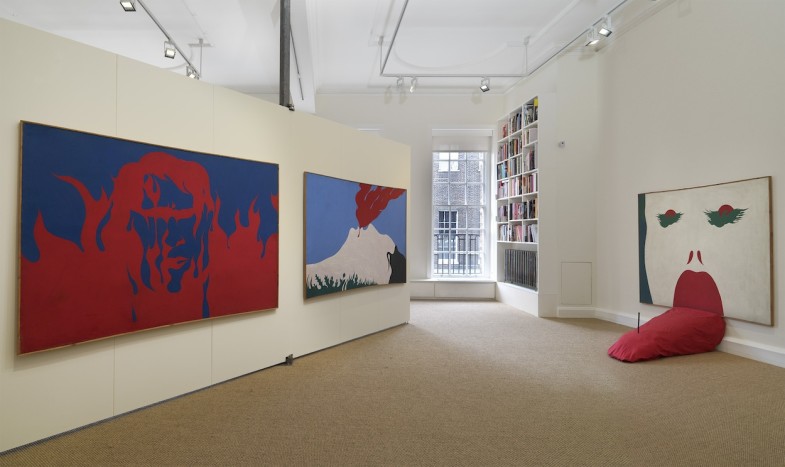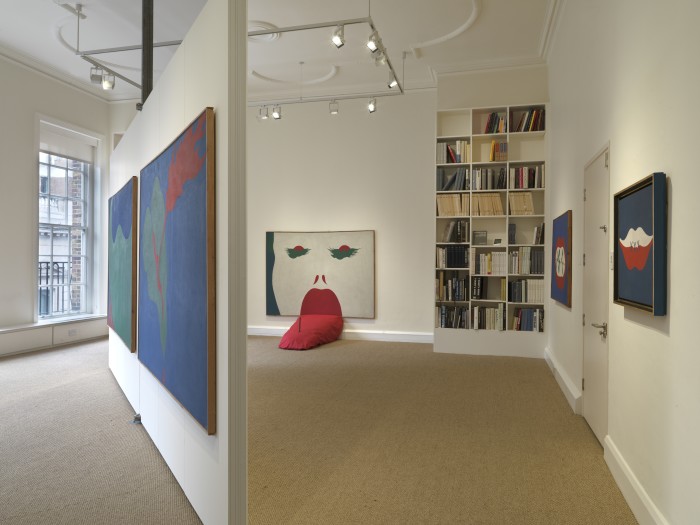Luxembourg & Dayan London will present a solo exhibition of paintings by the Polish artist and poet Jerzy “Jurry” Zieliński (1943-1980). In a series of paintings that conflate the aesthetics of Communist propaganda with the signifiers of Pop Art and tropes of Art Nouveau, Zieliński deployed an esoteric series of symbols to explore life’s grand themes of national identity, religion, eroticism and politics. Strategically paring his palette down to flattened areas of red, white, blue and green, and working within a set group of repeated emblems, Zieliński radically departed from the somberness expected of Polish art. One of the rare Polish artists to take up the Pop Art style during the 1960s and ‘70s, he made works that used a sly reverse psychology replete with potent anti-Establishment messages. Owing to its radical intent, Zieliński’s work has long been neglected by the Polish art historical mainstream and is only just receiving recognition internationally for its relationship to the wider tides of postwar art.
In 1967, Zieliński and his art school colleague Jan Dobkowski allied themselves in a mini-collective they referred to as Neo-Neo-Neo, an ironic moniker that highlighted their belief that nothing in the prevailing style of the Warsaw Fine Arts Academy was new or daring. “Neo-Neo-Neo is not a doctrine,” they wrote. “It is a call, we call for egalitarian art: does nobody have the courage to physiologically feel the urge to create?” Zieliński coined the American sounding nickname “Jurry” and Dobkowski dubbed himself “Dobson,” Westernizations that constituted political actions in themselves. After several common projects, the two artists parted ways and Neo-Neo-Neo soon faded from the memory of the Polish art world, though Zieliński continued to explore his fundamental concerns through writing and painting.
For Zieliński, the distilled language of Pop Art was the ideal vehicle to propell a distinctive style that was shot through with witty, incisive comments on the dilemmas of the age. While Pop Art in the West was primarily concerned with consumer culture and mass media, Zieliński’s version investigated a more austere set of political concerns. The purposeful simplification and reliance upon stylized symbols in Zieliński’s canvases functioned in direct opposition to Poland’s national doctrine of Social Realism, which informed ‘acceptable’ painting both before and after the Stalinization of Communist Poland. Appropriating the familiar iconography of Communist propaganda posters, Zieliński converted the power of a limited visual syntax into social critique. To underline his dissent, Zieliński proclaimed himself “Jurry – Polska B,” referencing the historical, political and cultural distinction between his nation’s more favored, developed and powerful west (Poland A) and its economically and socially downtrodden east (Poland B).
Though Zieliński was certainly aware of the conventions of American Pop Art (his Neo-Neo-Neo writings cited the influence of an eclectic group of Western artists, from de Chirico and George Segal to Francis Bacon and Martial Raysse), his use of the movement’s familiar images – lips, birds and other simplified symbols – is far removed from the works of John Pasche, Andy Warhol and Tom Wesselman. In Zieliński’s paintings, a mouth always offers double meaning, telegraphing not only lurid possibilities but also a powerful message about the illusions of double-talk offered under the rubric of Communism and Soviet domination. Transcending monolithic interpretation, Zieliński’s sometimes grotesque, sometimes humorous, and always lush paintings reference the dualities of hedonism and asceticism, pleasure and protest. By limiting his iconography to symbols already bloated with historical and social connotations, Zieliński was able to suggest that meaning can be reconfigured via context and intention.
This exhibition, organized in collaboration with Galeria Zderzak, Krakow, and the artist’s widow, Wiesława Zielińska, includes works from the collections of Zachęta - National Gallery of Art, Warsaw and of the Polish Modern Art Foundation, Warsaw. The exhibition follows the success of the presentation of three paintings by Zieliński at Oko, New York in April 2013 (Oko is an East Village art exhibition space conceived by Alison Gingeras in collaboration with Luxembourg & Dayan gallery as a venue for curatorial experimentation).
Frieze Masters
Luxembourg & Dayan will present an exhibition titled “Pop Not Pop” at their booth in Frieze Masters. The exhibition will explore the similarities and differences between classical and early British and American Pop works from the 1960s with parallel movements outside of the Anglo-Saxon world such as Neo-Dada, Capitalist Realism, Arte Povera, Nouveau Réalisme. A work by Jerzy “Jurry” Zieliński will also feature as part of “Pop Not Pop”.




